Utilizing Marble Wastewater in Cement Pastes and Mortars for Enhanced Physico-Mechanical and Microstructural Properties
Abstract
:1. Introduction
2. Experimental Section
2.1. Materials and Solutions
2.2. Mix Percentages and Sample Fabrication
2.3. Testing Methods and Characterization
3. Results and Discussion
3.1. Water Quality Analysis
3.2. Standard Consistency and Setting Time Analysis
3.3. Effects of Marble Wastewater on Water Absorption and Porosity of Mortar
3.4. Effect of Marble Wastewater on Mechanical Properties of Mortar
3.5. Ultrasonic Pulse Velocity (UPV)
3.6. Electrical Resistivity (ER)
3.7. Infrared Spectroscopy Analysis
3.8. SEM and EDX Analyses
3.9. X-ray Diffraction Analysis
4. Conclusions
- The use of marble wastewater (MWW) slightly delays the setting of cement pastes, as shown by the setting time analysis. This retardation effect occurs because, in the initial stages, the cement particles are coated with tiny marble waste particles, requiring more time for the cement particles to fully hydrate.
- As the percentage of marble wastewater replacement increased, the water absorption and porosity of the mortar samples significantly decreased. This effect is due to the filler action of the tiny particles present in the marble wastewater.
- The compressive strength of cement mortar improved as the percentage of marble wastewater used in place of tap water increased. The 28-day compressive strength of the mortar increased by up to 6% with 100% replacement by marble wastewater. The pore-filling activity of the hydrated cement particles used in mortar or concrete production is essential for enhancing the material’s strength.
- The UPV values increased with the use of marble wastewater, indicating the formation of cement mortar with fewer voids and flaws. Additionally, the ER values of the marble wastewater-based cement mortar increased compared to the control sample, indicating a lower risk of corrosion.
- According to the analytical characterization, marble wastewater significantly influenced portlandite development and CSH formation at higher replacement levels. SEM investigation revealed that the MWW-based mortar, with fewer capillary pores, had a more compact and denser microstructure compared to the control mortar, which had larger capillary pores.
Author Contributions
Funding
Data Availability Statement
Conflicts of Interest
References
- Ahmad, T.; Ahmad, K.; Alam, M. Sustainable Management of Water Treatment Sludge through 3 ‘R’Concept. J. Clean. Prod. 2016, 124, 1–13. [Google Scholar] [CrossRef]
- Datchossa, A.T.; Doko, V.K.; Kabay, N.; Olodo, E.E.T.; Omur, T. The Influence of Ground and Unground Rice Husk Ash on The Physico-Mechanical and Microstructural Properties of Cement Mortars. Iran. J. Sci. Technol. Trans. Civ. Eng. 2021, 14, 2189–2202. [Google Scholar] [CrossRef]
- Varshney, H.; Khan, R.A.; Khan, I.K. Sustainable Use of Different Wastewater in Concrete Construction: A Review. J. Build. Eng. 2021, 41, 102411. [Google Scholar] [CrossRef]
- Heikal, M.; Ismail, M.N.; Ibrahim, N.S. Physico-Mechanical, Microstructure Characteristics and Fire Resistance of Cement Pastes Containing Al2O3 Nano-Particles. Constr. Build. Mater. 2015, 91, 232–242. [Google Scholar] [CrossRef]
- Adewoyin, O.; Adesina, A.; Das, S. Physico-Thermal and Microstructural Properties of Thermal-Efficient Mortars Made with Low Cement Content. Constr. Build. Mater. 2022, 325, 126850. [Google Scholar] [CrossRef]
- Abdullayev, A.; Bekheet, M.F.; Hanaor, D.A.H.; Gurlo, A. Materials and Applications for Low-Cost Ceramic Membranes. Membranes 2019, 9, 105. [Google Scholar] [CrossRef] [PubMed]
- Vajnhandl, S.; Valh, J.V. The Status of Water Reuse in European Textile Sector. J. Environ. Manag. 2014, 141, 29–35. [Google Scholar] [CrossRef] [PubMed]
- Miller, S.A.; Horvath, A.; Monteiro, P.J.M. Impacts of Booming Concrete Production on Water Resources Worldwide. Nat. Sustain. 2018, 1, 69–76. [Google Scholar] [CrossRef]
- Lee, H.P.; Awang, A.Z.; Omar, W.; Tiong, P.L. Derivation of Complete Stress–Strain Curve for SSTT-Confined High-Strength Concrete in Compression. J. Test. Eval. 2018, 46, 168–177. [Google Scholar] [CrossRef]
- Karthika, R.B.; Vidyapriya, V.; Sri, K.V.N.; Beaula, K.M.G.; Harini, R.; Sriram, M. Experimental Study on Lightweight Concrete Using Pumice Aggregate. Mater. Today Proc. 2021, 43, 1606–1613. [Google Scholar] [CrossRef]
- Silva, J.A. Wastewater Treatment and Reuse for Sustainable Water Resources Management: A Systematic Literature Review. Sustainability 2023, 15, 10940. [Google Scholar] [CrossRef]
- Khan, M.M.H.; Sobuz, M.H.R.; Meraz, M.M.; Tam, V.W.Y.; Hasan, N.M.S.; Shaurdho, N.M.N. Effect of Various Powder Content on the Properties of Sustainable Self-Compacting Concrete. Case Stud. Constr. Mater. 2023, 19, e02274. [Google Scholar] [CrossRef]
- Jo, B.W.; Sikandar, M.A.; Chakraborty, S.; Baloch, Z. Investigation of the Acid and Sulfate Resistance Performances of Hydrogen-Rich Water Based Mortars. Constr. Build. Mater. 2017, 137, 1–11. [Google Scholar] [CrossRef]
- Jo, B.W.; Sikandar, M.A.; Chakraborty, S.; Baloch, Z. Strength and Durability Assessment of Portland Cement Mortars Formulated from Hydrogen-Rich Water. Adv. Mater. Sci. Eng. 2017, 2017, 2526130. [Google Scholar] [CrossRef]
- Asaad, M.A.; Ismail, M.; Tahir, M.M.; Huseien, G.F.; Raja, P.B.; Asmara, Y.P. Enhanced Corrosion Resistance of Reinforced Concrete: Role of Emerging Eco-Friendly Elaeis Guineensis/Silver Nanoparticles Inhibitor. Constr. Build. Mater. 2018, 188, 555–568. [Google Scholar] [CrossRef]
- Chakraborty, S.; Mandal, R.; Chattopadhyay, S.; Chakraborty, S. Investigation on the Effectiveness of Electrolyzed Water in Controlling the Early Age Properties of Cement Mortar. Constr. Build. Mater. 2019, 211, 1–11. [Google Scholar] [CrossRef]
- Su, N.; Miao, B.; Liu, F.-S. Effect of Wash Water and Underground Water on Properties of Concrete. Cem. Concr. Res. 2002, 32, 777–782. [Google Scholar] [CrossRef]
- Nirmalkumar, K.; Sivakumar, V. Corrosion Studies on Concrete Using Treated and Untreated Textile Effluent and Impact of Corrosion Inhibitor. J. Sust. Dev. 2008, 1, 68–72. [Google Scholar] [CrossRef]
- Al-Jabri, K.S.; Al-Saidy, A.H.; Taha, R.; Al-Kemyani, A.J. Effect of Using Wastewater on the Properties of High Strength Concrete. Procedia Eng. 2011, 14, 370–376. [Google Scholar] [CrossRef]
- Ismail, Z.Z.; Al-Hashmi, E.A. Assessing the Recycling Potential of Industrial Wastewater to Replace Fresh Water in Concrete Mixes: Application of Polyvinyl Acetate Resin Wastewater. J. Clean. Prod. 2011, 19, 197–203. [Google Scholar] [CrossRef]
- Tsimas, S.; Zervaki, M. Reuse of Waste Water from Ready-mixed Concrete Plants. Manag. Environ. Qual. Int. J. 2011, 22, 7–17. [Google Scholar] [CrossRef]
- Wasserman, B. Wash Water in the Mix: Effects on the Compressive Strength of Concrete. Int. J. Constr. Educ. Res. 2012, 8, 301–316. [Google Scholar] [CrossRef]
- Nikhil, T.R.; Sushma, R.; Gopinath, S.M.; Shanthappa, B.C. Impact of Water Quality on Strength Properties of Concrete. Indian J. Appl. Res. 2014, 4. [Google Scholar]
- Asadollahfardi, G.; Asadi, M.; Jafari, H.; Moradi, A.; Asadollahfardi, R. Experimental and Statistical Studies of Using Wash Water from Ready-Mix Concrete Trucks and a Batching Plant in the Production of Fresh Concrete. Constr. Build. Mater. 2015, 98, 305–314. [Google Scholar] [CrossRef]
- Çomak, B. Effects of Use of Alkaline Mixing Waters on Engineering Properties of Cement Mortars. Eur. J. Environ. Civ. Eng. 2018, 22, 736–754. [Google Scholar] [CrossRef]
- Khan, K.; Ahmad, W.; Amin, M.N.; Ahmad, A.; Nazar, S.; Alabdullah, A.A.; Arab, A.M.A. Exploring the Use of Waste Marble Powder in Concrete and Predicting Its Strength with Different Advanced Algorithms. Materials 2022, 15, 4108. [Google Scholar] [CrossRef] [PubMed]
- Oza, R.B.; Kangda, M.Z.; Agrawal, M.R.; Vakharia, P.R.; Solanki, D.M. Marble Dust as a Binding Material in Concrete: A Review. Mater. Today Proc. 2022, 60, 421–430. [Google Scholar] [CrossRef]
- 6Wresearch. Saudi Arabia Marble Market (2020–2026): Trends, Outlook & Forecast, Saudi Arabia Marble Market (2020–2026). Available online: https://www.6wresearch.com/industry-report/saudi-arabia-marble-market-2020-2026 (accessed on 1 July 2024).
- Ahmad, M.; Rajapaksha, A.U.; Lim, J.E.; Zhang, M.; Bolan, N.; Mohan, D.; Vithanage, M.; Lee, S.S.; Ok, Y.S. Biochar as a Sorbent for Contaminant Management in Soil and Water: A Review. Chemosphere 2014, 99, 19–33. [Google Scholar] [CrossRef]
- Mehdi, A.; Chaudhry, M.J. Diagnostic Study Marble & Granite Cluster Rawalpindi–Pakistan; UNIDO-SMEDA Cluster Development Programme: Rawalpindi, Pakistan, 2006. [Google Scholar]
- Ahmed, K.; Nizami, S.S.; Raza, N.Z.; Habib, F. The Effect of Silica on the Properties of Marble Sludge Filled Hybrid Natural Rubber Composites. J. King Saud Univ.-Sci. 2013, 25, 331–339. [Google Scholar] [CrossRef]
- Nasrullah, R.N.; Bibi, H.; Iqbal, M.; Durrani, M.I. Pollution Load in Industrial Effluent and Ground Water of Gadoon Amazai Industrial Estate (GAIE) Swabi, NWFP. J. Agric. Biol. Sci. 2006, 1, 18–24. [Google Scholar]
- ASTM C150-18; Standard Specification for Portland Cement. ASTM International: West Conshohocken, PA, USA, 2018.
- ASTM C33/C33M–18; Standard Specification for Concrete Aggregates. ASTM International: West Conshohocken, PA, USA, 2018.
- ASTM C305-20, A; Standard Practice for Mechanical Mixing of Hydraulic Cement Pastes and Mortars of Plastic Consistency. ASTM International: West Conshohocken, PA, USA, 2018.
- ASTM C187, A; Standard Test Method for Normal Consistency of Hydraulic Cement. ASTM International: West Conshohocken, PA, USA, 2004.
- ASTM, C.191-08; Standard Test Methods for Time of Setting of Hydraulic Cement by Vicat Needle. ASTM International: West Conshohocken, PA, USA, 2008.
- ASTM, C642—06; Standard Test Method for Density, Absorption, and Voids in Hardened Concrete. ASTM International: West Conshohocken, PA, USA, 2006; 3.
- ASTM, C109; Standard Test Method for Compressive Strength of Hydraulic Cement Mortars. ASTM International: West Conshohocken, PA, USA, 2008.
- ASTM, C597; Standard Test Method for Pulse Velocity through Concrete. ASTM International: West Conshohocken, PA, USA, 2016.
- Vardhan, K.; Goyal, S.; Siddique, R.; Singh, M. Mechanical Properties and Microstructural Analysis of Cement Mortar Incorporating Marble Powder as Partial Replacement of Cement. Constr. Build. Mater. 2015, 96, 615–621. [Google Scholar] [CrossRef]
- Ma, B.; Wang, J.; Tan, H.; Li, X.; Cai, L.; Zhou, Y.; Chu, Z. Utilization of Waste Marble Powder in Cement-Based Materials by Incorporating Nano Silica. Constr. Build. Mater. 2019, 211, 139–149. [Google Scholar] [CrossRef]
- Neville, A.M. Properties of Concrete; Longman: London, UK, 1995; Volume 4. [Google Scholar]
- Mandal, R.; Chakraborty, S.; Chakraborty, P.; Chakraborty, S. Development of the Electrolyzed Water Based Set Accelerated Greener Cement Paste. Mater. Lett. 2019, 243, 46–49. [Google Scholar] [CrossRef]
- Li, L.G.; Huang, Z.H.; Tan, Y.P.; Kwan, A.K.H.; Liu, F. Use of Marble Dust as Paste Replacement for Recycling Waste and Improving Durability and Dimensional Stability of Mortar. Constr. Build. Mater. 2018, 166, 423–432. [Google Scholar] [CrossRef]
- Ulubeyli, G.C.; Artir, R. Properties of Hardened Concrete Produced by Waste Marble Powder. Procedia-Soc. Behav. Sci. 2015, 195, 2181–2190. [Google Scholar] [CrossRef]
- Gupta, L.K.; Vyas, A.K. Impact on Mechanical Properties of Cement Sand Mortar Containing Waste Granite Powder. Constr. Build. Mater. 2018, 191, 155–164. [Google Scholar] [CrossRef]
- Aliabdo, A.A.; Abd Elmoaty, M.; Auda, E.M. Re-Use of Waste Marble Dust in the Production of Cement and Concrete. Constr. Build. Mater. 2014, 50, 28–41. [Google Scholar] [CrossRef]
- Demirel, B. The Effect of the Using Waste Marble Dust as Fine Sand on the Mechanical Properties of the Concrete. Int. J. Phys. Sci. 2010, 5, 1372–1380. [Google Scholar]
- Shekarchi, M.; Yazdian, M.; Mehrdadi, N. Use of Biologically Treated Domestic Waste Water in Concrete. Kuwait J. Sci. Eng. 2012, 39, 97–111. [Google Scholar]
- Saxena, S.; Tembhurkar, A.R. Impact of Use of Steel Slag as Coarse Aggregate and Wastewater on Fresh and Hardened Properties of Concrete. Constr. Build. Mater. 2018, 165, 126–137. [Google Scholar] [CrossRef]
- Noruzman, A.H.; Muhammad, B.; Ismail, M.; Abdul-Majid, Z. Characteristics of Treated Effluents and Their Potential Applications for Producing Concrete. J. Environ. Manag. 2012, 110, 27–32. [Google Scholar] [CrossRef] [PubMed]
- Omar, O.M.; Abd Elhameed, G.D.; Sherif, M.A.; Mohamadien, H.A. Influence of Limestone Waste as Partial Replacement Material for Sand and Marble Powder in Concrete Properties. HBRC J. 2012, 8, 193–203. [Google Scholar] [CrossRef]
- Chawla, A.; Kabeer, K.I.S.A.; Vyas, A.K. Evaluation of Strength and Durability of Lean Concrete Mixes Containing Marble Waste as Fine Aggregate. Eur. J. Environ. Civ. Eng. 2020, 24, 1398–1413. [Google Scholar] [CrossRef]
- Richard, T.; Mercury, L.; Poulet, F.; D’Hendecourt, L. Diffuse Reflectance Infrared Fourier Transform Spectroscopy as a Tool to Characterise Water in Adsorption/Confinement Situations. J. Colloid Interface Sci. 2006, 304, 125–136. [Google Scholar] [CrossRef]
- Malhotra, V.M.; Carino, N.J. Handbook on Nondestructive Testing of Concrete; CRC Press: Boca Raton, FL, USA, 2003. [Google Scholar]
- Nanni, A. Guide for the Design and Construction of Concrete Reinforced with FRP Bars (ACI 440.1 R-03). In Proceedings of the Structures Congress 2005: Metropolis and Beyond, New York, NY, USA, 20–24 April 2005; pp. 1–6. [Google Scholar]
- Asadollahfardi, G.; Mahdavi, A.R. The Feasibility of Using Treated Industrial Wastewater to Produce Concrete. Struct. Concr. 2019, 20, 123–132. [Google Scholar] [CrossRef]
- Singh, M.; Srivastava, A.; Bhunia, D. An Investigation on Effect of Partial Replacement of Cement by Waste Marble Slurry. Constr. Build. Mater. 2017, 134, 471–488. [Google Scholar] [CrossRef]
- Sikandar, M.A.; Wazir, N.R.; Khan, A.; Nasir, H.; Ahmad, W.; Alam, M. Effect of Various Anti-Washout Admixtures on the Properties of Non-Dispersible Underwater Concrete. Constr. Build. Mater. 2020, 245, 118469. [Google Scholar] [CrossRef]
- Trezza, M.A.; Lavat, A.E. Analysis of the System 3CaO· Al2O3–CaSO4· 2H2O–CaCO3–H2O by FT-IR Spectroscopy. Constr. Build. Mater. 2001, 31, 869–872. [Google Scholar] [CrossRef]
- Choudhary, R.; Gupta, R.; Nagar, R. Impact on Fresh, Mechanical, and Microstructural Properties of High Strength Self-Compacting Concrete by Marble Cutting Slurry Waste, Fly Ash, and Silica Fume. Constr. Build. Mater. 2020, 239, 117888. [Google Scholar] [CrossRef]
- Chakraborty, S.; Jo, B.W.; Sikandar, M.A. Hydration Mechanism of the Hydrogen-Rich Water Based Cement Paste. J. Phys. Chem. C 2016, 120, 8198–8209. [Google Scholar] [CrossRef]
- Singh, M.; Saini, B.; Chalak, H.D. Long Term Evaluation of Engineered Cementitious Composite Containing Stone Slurry Powder. Constr. Build. Mater. 2020, 264, 120183. [Google Scholar] [CrossRef]
- Yoon, I.-H.; Moon, D.H.; Kim, K.-W.; Lee, K.-Y.; Lee, J.-H.; Kim, M.G. Mechanism for the Stabilization/Solidification of Arsenic-Contaminated Soils with Portland Cement and Cement Kiln Dust. J. Environ. Manag. 2010, 91, 2322–2328. [Google Scholar] [CrossRef] [PubMed]
- Grzeszczyk, S.; Jurowski, K.; Bosowska, K.; Grzymek, M. The Role of Nanoparticles in Decreased Washout of Underwater Concrete. Constr. Build. Mater. 2019, 203, 670–678. [Google Scholar] [CrossRef]
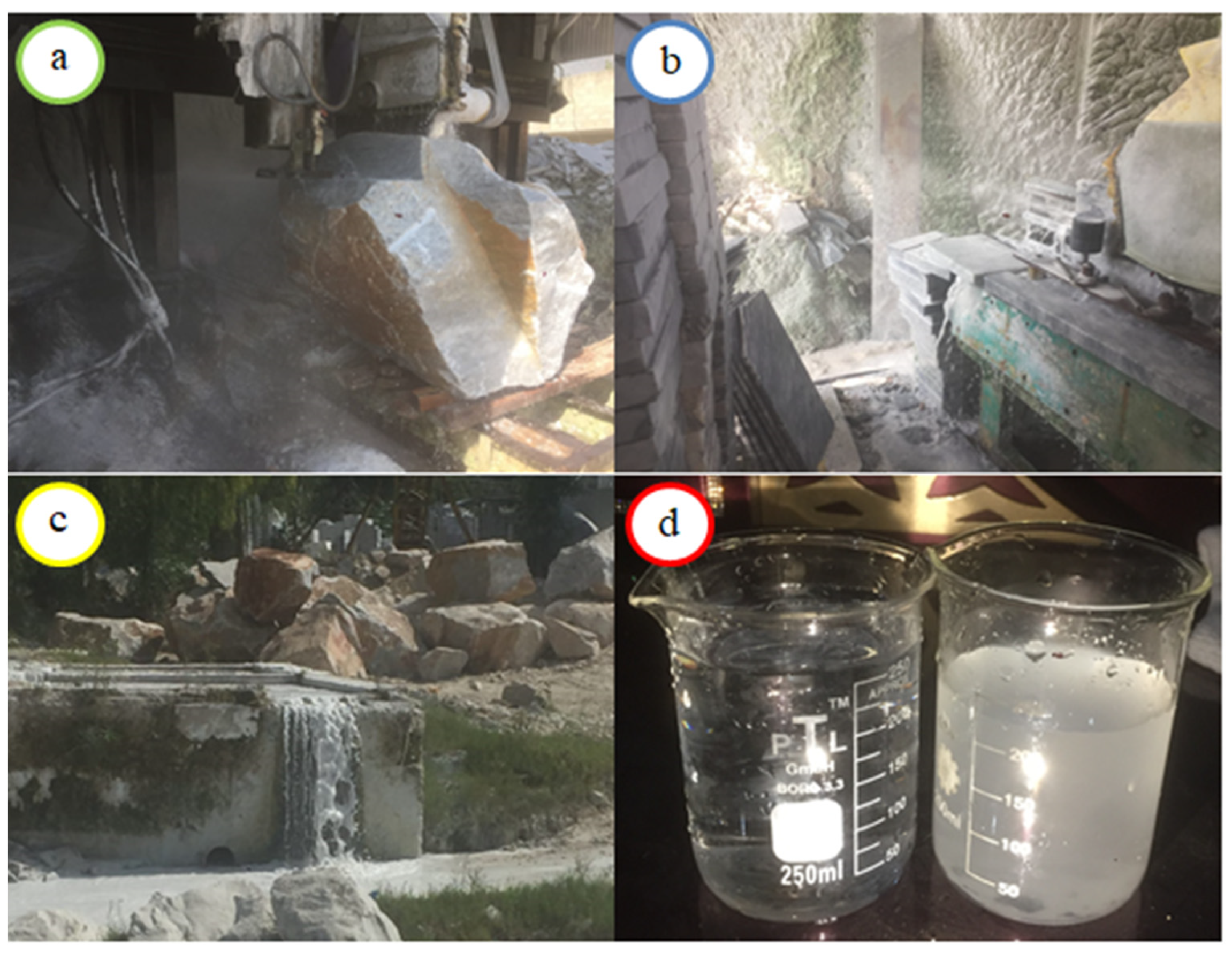
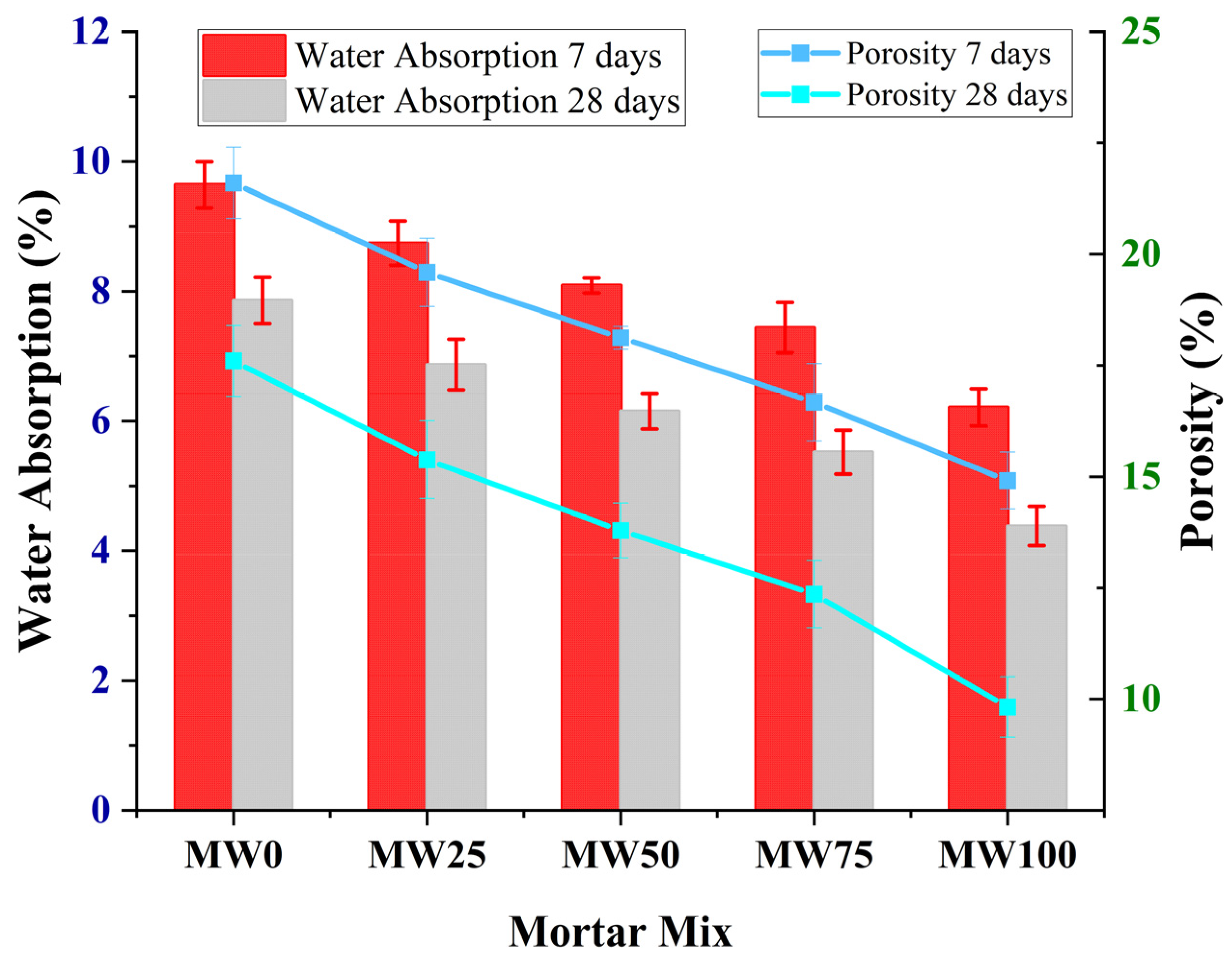
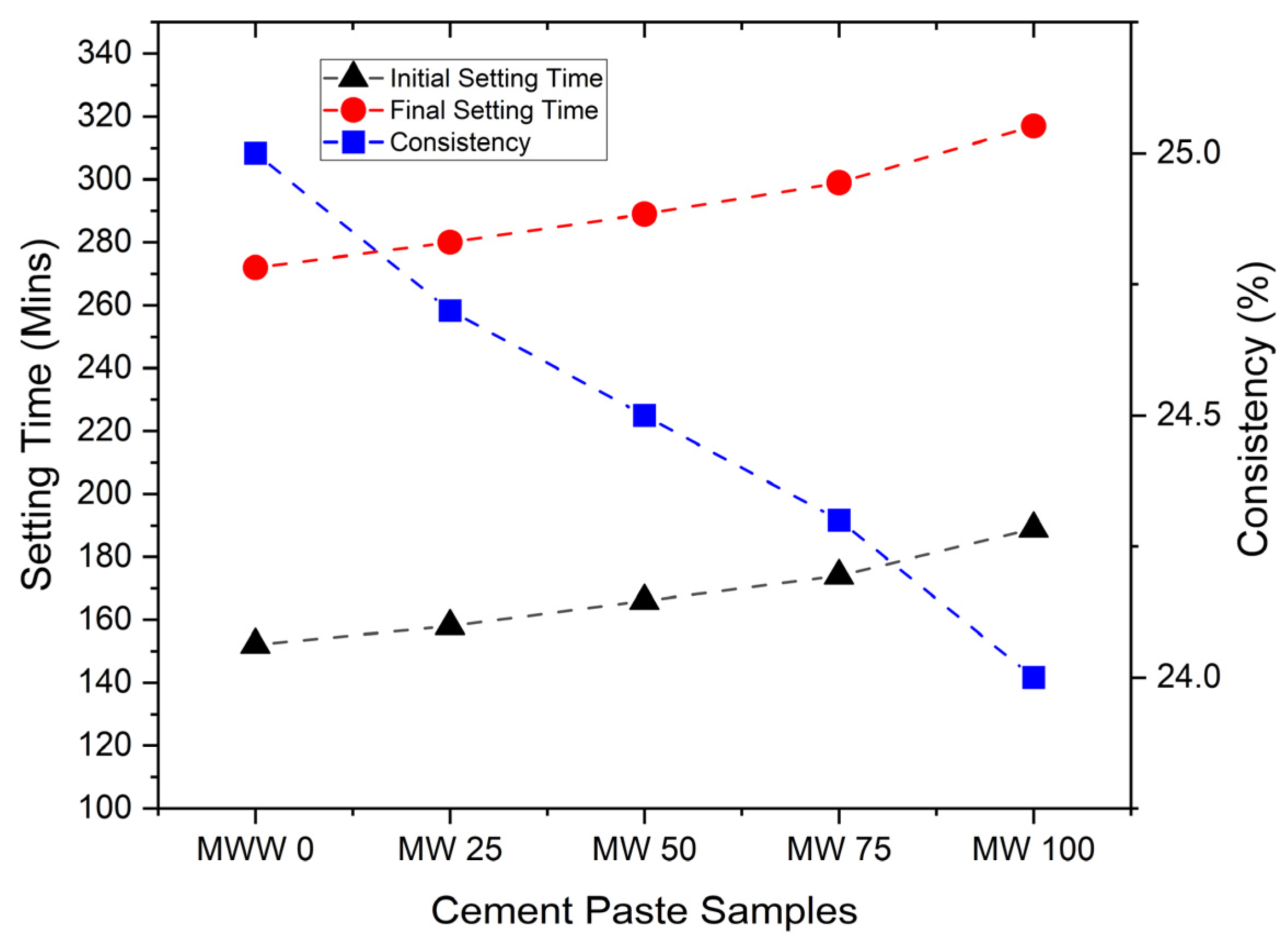

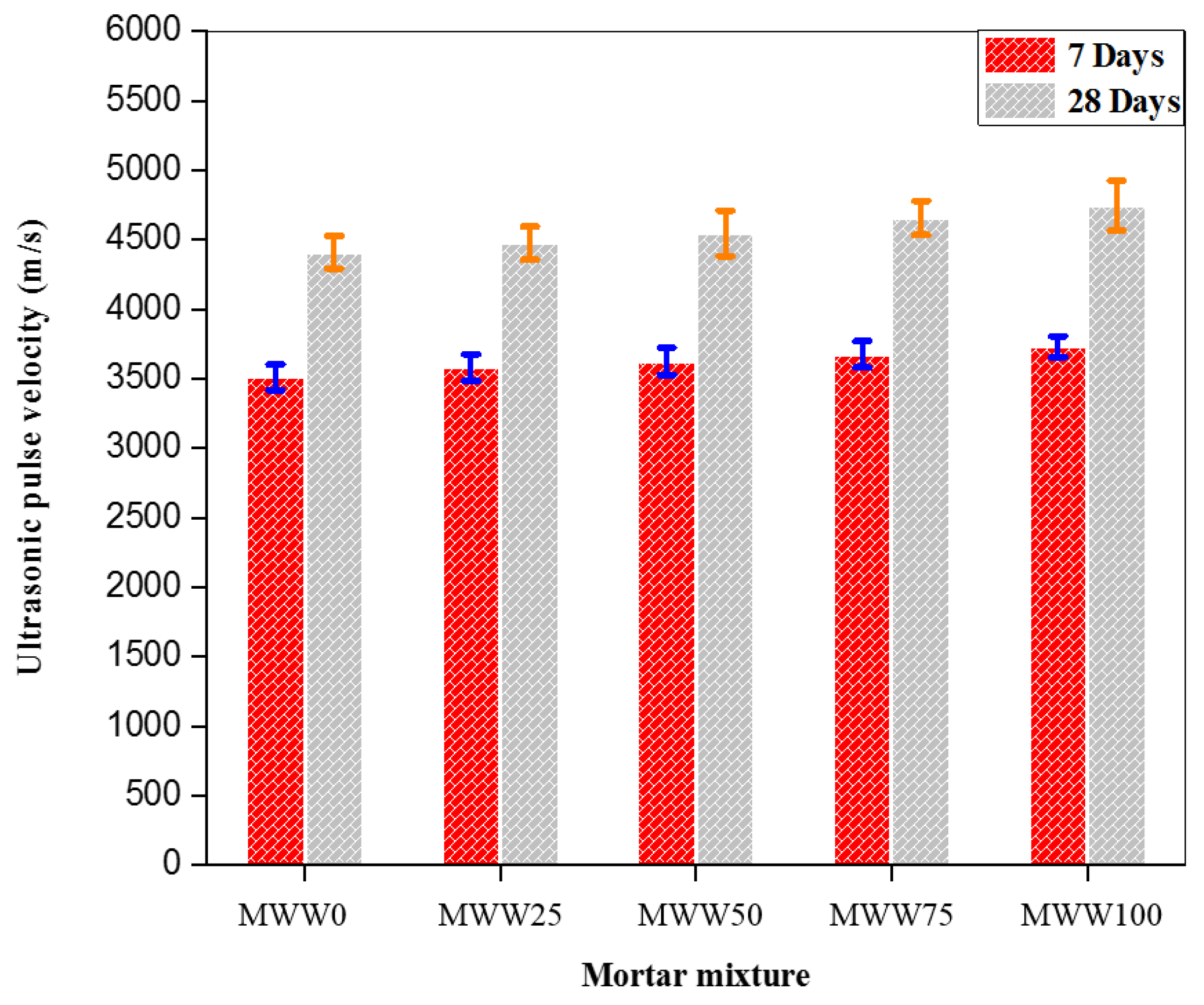
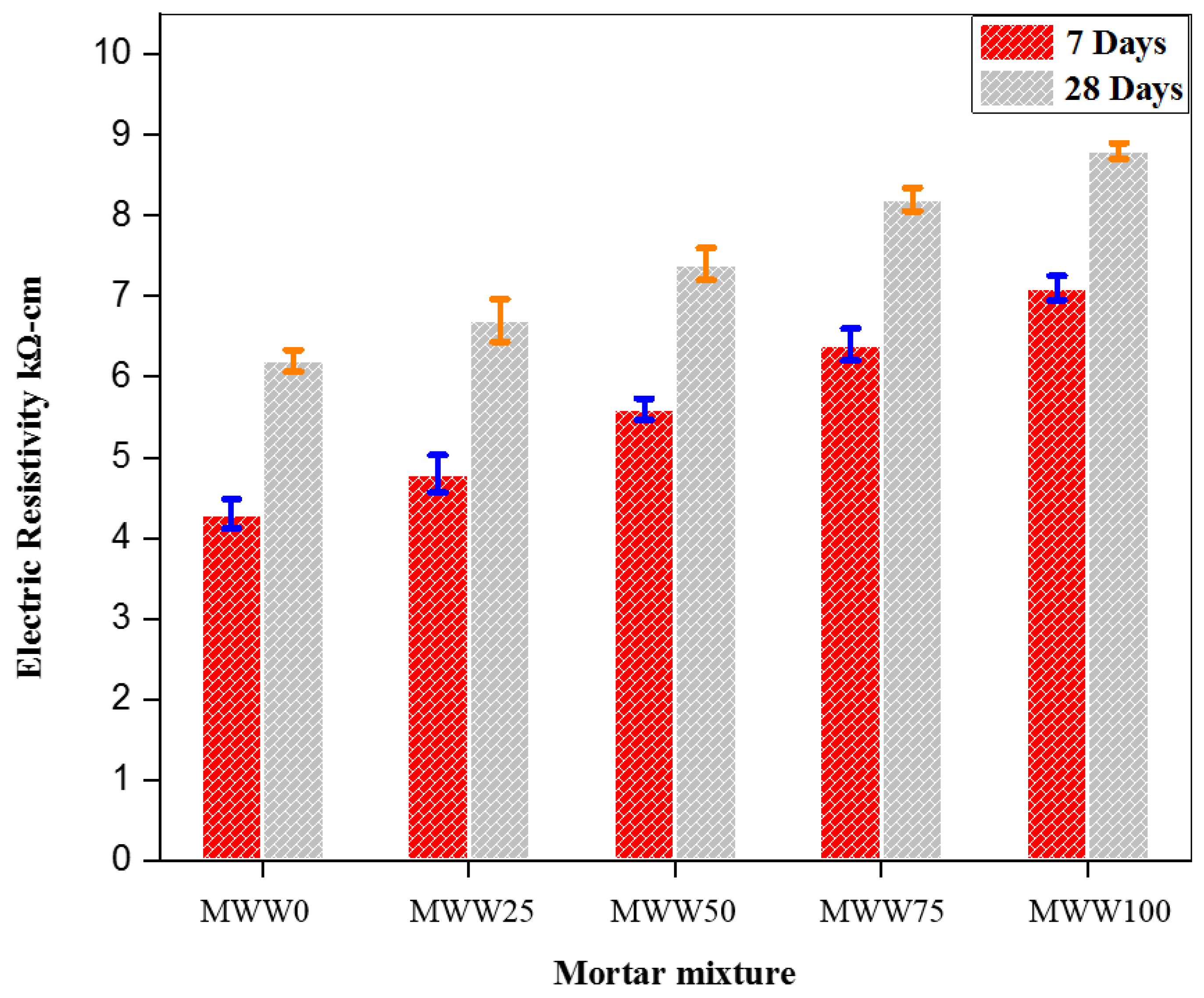

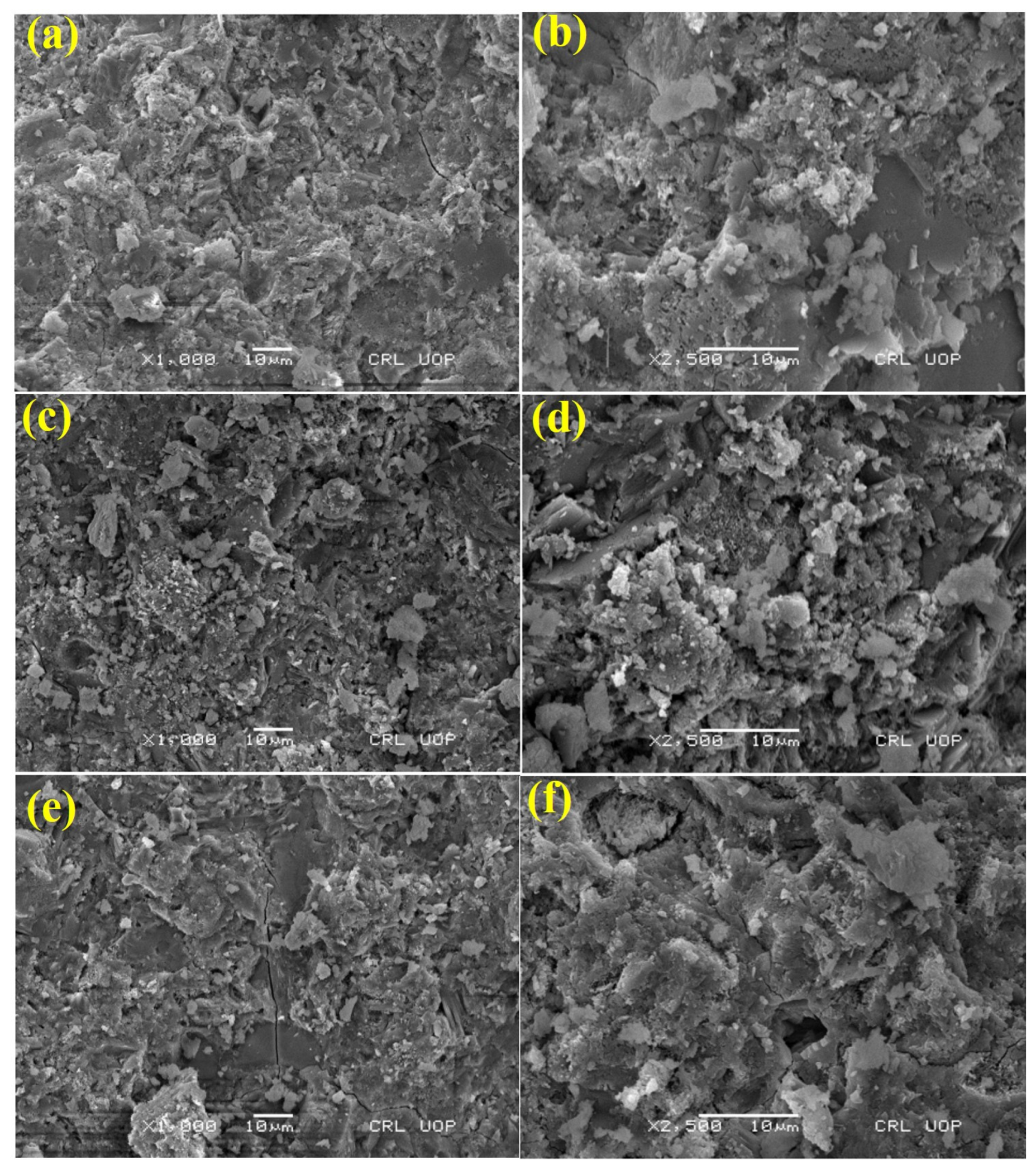
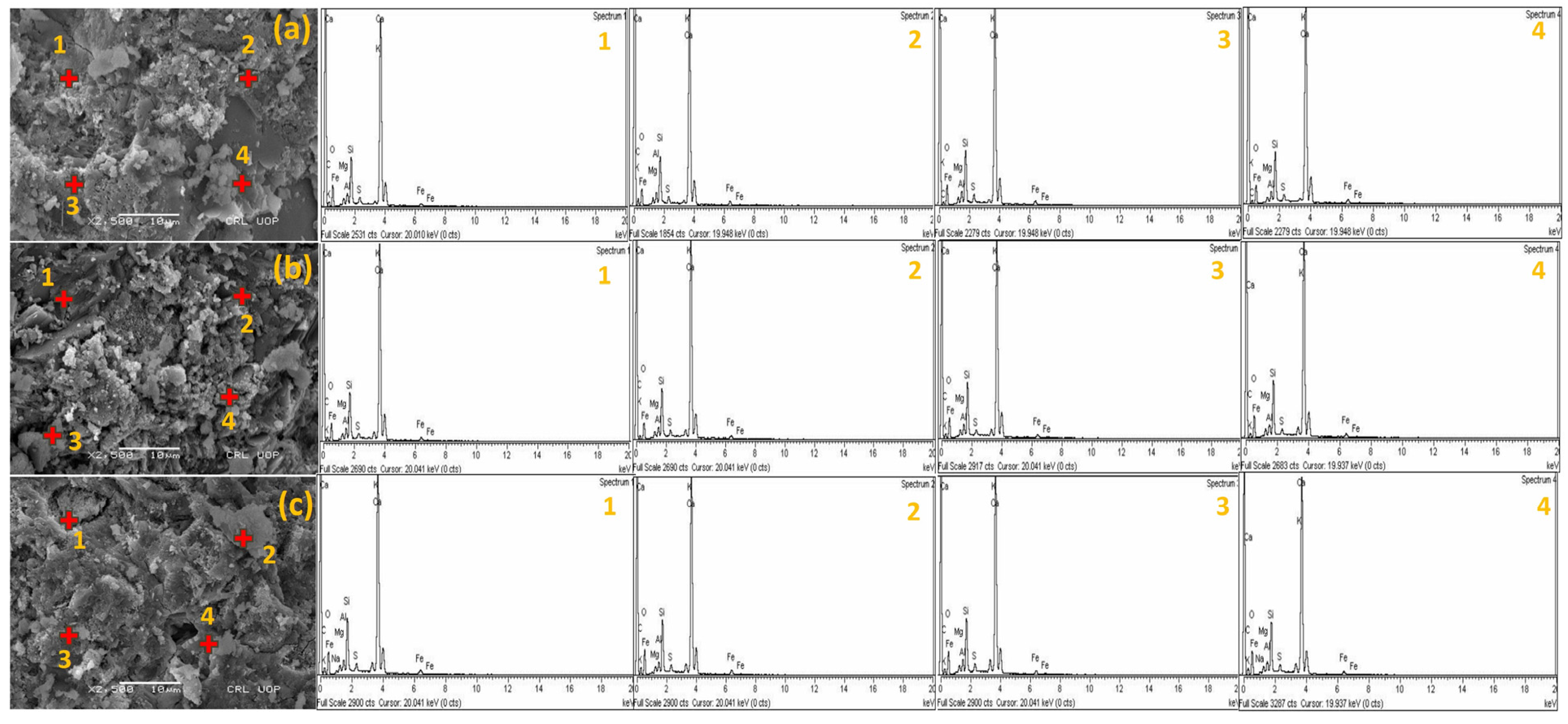
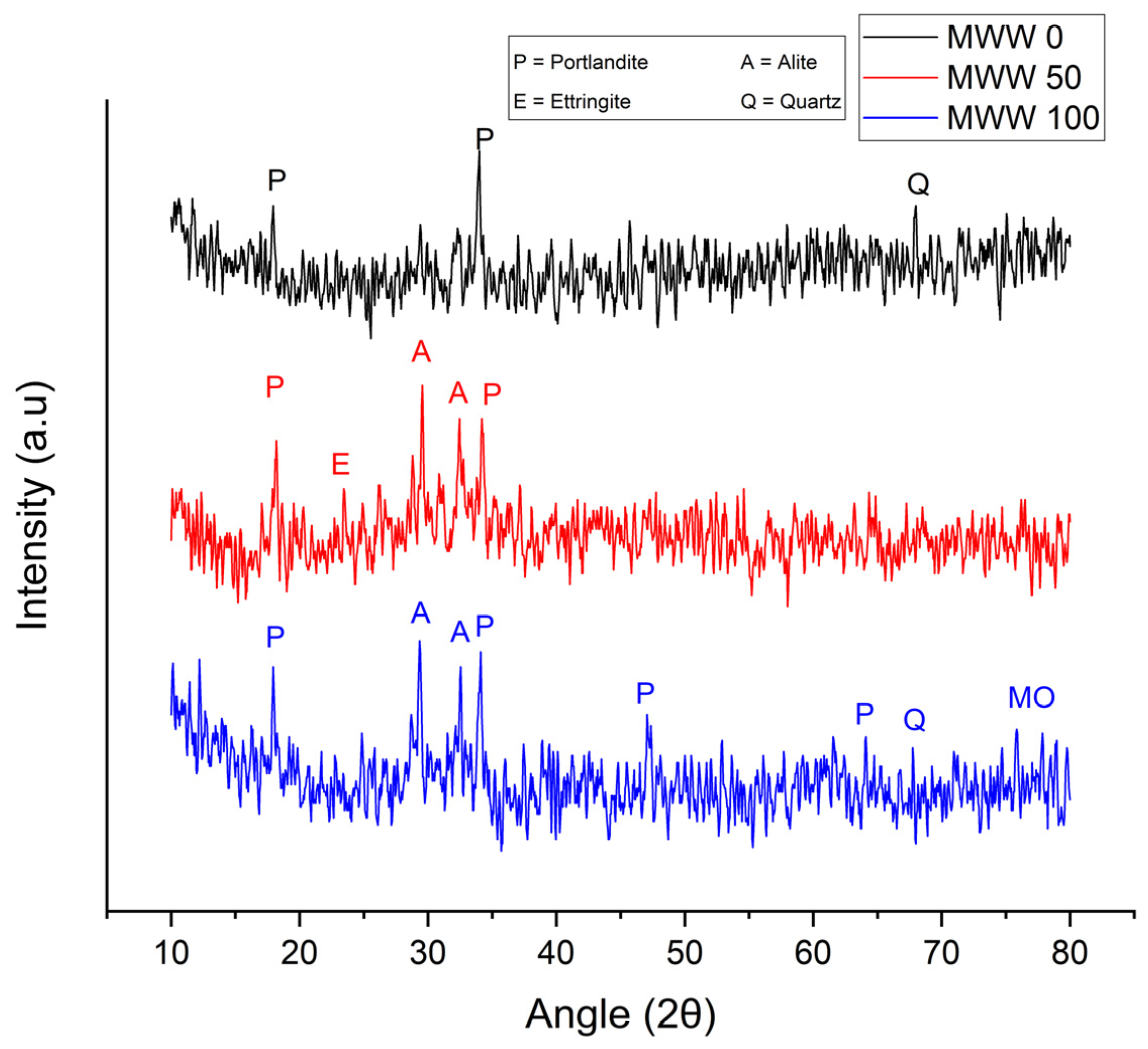
| Mixture ID | Cement (g) | Water (mL) | MWW (mL) |
|---|---|---|---|
| MWW 0 | 100 | 25.000 | 0.000 |
| MWW 25 | 100 | 18.525 | 6.175 |
| MWW 50 | 100 | 12.250 | 12.250 |
| MWW 75 | 100 | 6.075 | 18.225 |
| MWW 100 | 100 | 0.000 | 25.000 |
| Mixture ID | Cement (g) | Sand (g) | Water (mL) | MWW (mL) |
|---|---|---|---|---|
| MWW 0 | 100 | 275 | 48.500 | 0.000 |
| MWW 25 | 100 | 275 | 36.375 | 12.125 |
| MWW 50 | 100 | 275 | 24.250 | 24.250 |
| MWW 75 | 100 | 275 | 12.125 | 36.375 |
| MWW 100 | 100 | 275 | 0.000 | 48.500 |
| Sr. No. | Test | Unit | Wastewater | Tap Water |
|---|---|---|---|---|
| 1 | pH | Scale | 8.25 | 7.39 |
| 2 | Elec. conductivity | micro-mhos/cm | 529 | 479 |
| 3 | Turbidity | NTU | 432 | 1.07 |
| 4 | Total dissolved solids | ppm | 433 | 241 |
| 5 | Total alkalinity | ppm | 397 | 83 |
| 6 | Total hardness | ppm | 430 | 155 |
| 7 | Calcium hardness | ppm | 178 | 99 |
| 8 | Magnesium hardness | ppm | 252 | 57 |
| 9 | Chloride | ppm | 28.5 | 10.5 |
| 10 | Calcium content | ppm | 76.58 | 29.6 |
| 11 | Magnesium content | ppm | 66.25 | 35 |
| Mix ID | Al | Ca | C | S | Si | Mg | O | Si/Ca |
|---|---|---|---|---|---|---|---|---|
| MWW 0 | 1.77 | 43.51 | 8.60 | 0.87 | 7.30 | 1.28 | 34.50 | 0.17 |
| MWW 50 | 1.83 | 43.58 | 5.11 | 1.28 | 7.78 | 1.27 | 35.08 | 0.18 |
| MWW 100 | 1.59 | 44.45 | 6.48 | 0.92 | 7.97 | 1.23 | 34.04 | 0.18 |
Disclaimer/Publisher’s Note: The statements, opinions and data contained in all publications are solely those of the individual author(s) and contributor(s) and not of MDPI and/or the editor(s). MDPI and/or the editor(s) disclaim responsibility for any injury to people or property resulting from any ideas, methods, instructions or products referred to in the content. |
© 2024 by the authors. Licensee MDPI, Basel, Switzerland. This article is an open access article distributed under the terms and conditions of the Creative Commons Attribution (CC BY) license (https://creativecommons.org/licenses/by/4.0/).
Share and Cite
Alrowais, R.; Shakeel, K.; Bashir, M.T.; Sikandar, M.A.; Khan, M.M.H.; Ounais, W. Utilizing Marble Wastewater in Cement Pastes and Mortars for Enhanced Physico-Mechanical and Microstructural Properties. Buildings 2024, 14, 2403. https://doi.org/10.3390/buildings14082403
Alrowais R, Shakeel K, Bashir MT, Sikandar MA, Khan MMH, Ounais W. Utilizing Marble Wastewater in Cement Pastes and Mortars for Enhanced Physico-Mechanical and Microstructural Properties. Buildings. 2024; 14(8):2403. https://doi.org/10.3390/buildings14082403
Chicago/Turabian StyleAlrowais, Raid, Khalid Shakeel, Muhammad Tariq Bashir, Muhammad Ali Sikandar, Md. Munir Hayet Khan, and Wassef Ounais. 2024. "Utilizing Marble Wastewater in Cement Pastes and Mortars for Enhanced Physico-Mechanical and Microstructural Properties" Buildings 14, no. 8: 2403. https://doi.org/10.3390/buildings14082403






